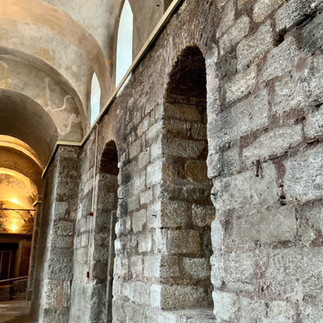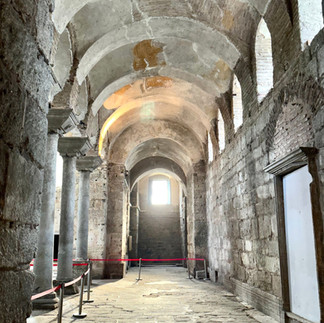Hagia Irene
- Jessica Cyphers
- Mar 26, 2023
- 2 min read

My second day in Istanbul started with a peak inside Hagia Irene. The Eastern Orthodox Church, which sits in Topkapi Palace's outer courtyard, caught my eye as my tour guide and I passed by, and I just had to go in.
The church wasn't much to look at on the outside—at least not compared with the likes of Hagia Sophia—but, as you'll see, it was hauntingly beautiful inside in an "old castle" kind of way.
Images of the exterior and entrance to the church.
History. Hagia Irene, which means "sacred" or "divine peace," is the oldest known church in Istanbul. It was built in 330 A.D. during Constantine's rule (before Hagia Sophia, which was dedicated in 360) on the site of an old temple. A typical Byzantine structure, the church is the only one in Istanbul that was never converted into a mosque. Both Hagia Irene and Hagia Sophia were devastated during the Nika Revolt of 532 and then rebuilt by Justinian (527–565).
After the fall of Constantinople to the Ottoman Empire in 1453, Hagia Irene was turned into a loot and gun warehouse. In 1846, Turkish museology artifacts were put on display in the church, and in 1986 it became the country's first official museum under the name of Müze-i Hümayun (Imperial Museum). Later, the weapons collection was reorganized and it served as the first Military Museum between 1908 and 1930.
Today the church is used as a museum (of the church itself) and a concert hall. Unfortunately, part of the interior of the church was being renovated when I was there, but, man—I would love to see a concert here someday.

Art Inside the Church. In typical Byzantine tradition, the church contains a unique vestige of the Iconoclastic art. The apse semi-dome and the bema arch are covered with mosaics. There are also frescoes on the south side aisle. These mosaics date back to about the 8th century. The aspse, pictured above and below, contains a mosaic of the cross outlined in black with a gold background.

The Cross. The church was severely damaged by an earthquake in 740 and was reconstructed by Constantine V (740-775). The famous Iconoclastic cross was put in during this time. On the bema arch there is an inscription of Psalm 64: 4-5 on the inner side, and then on the outer side there is an inscription of Amos 6:6.

My Takeaway. Hagia Irene was gorgeous. I enjoyed it just as much as Topkapi Palace, which I visited next and which is arguably much more famous and glamorous. The best part to me was that, particularly compared to many other places in Istanbul, my tour guide and I had it all to ourselves.
If you ever make it to Istanbul, stop in Hagia Irene on your way to Topkapi Palace. You won't regret it.
Sources: Hagia Irene Museum, Hagia Irene, The Byzantine Legacy


























Hi Jessica,
Thank you for sharing about this amazing old church. What a rich history. It's interesting it's the only church which didn't get converted to a mosque.